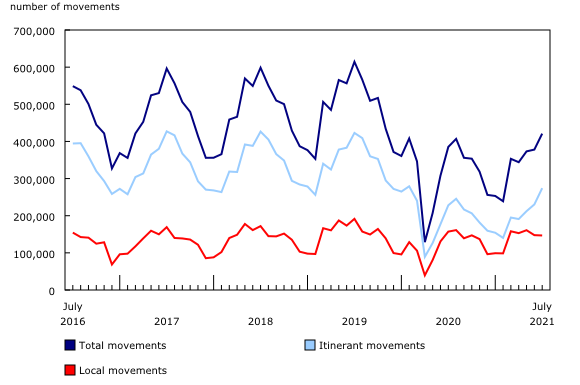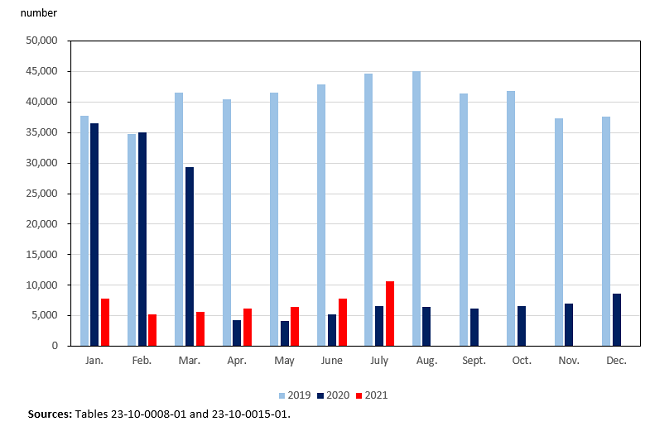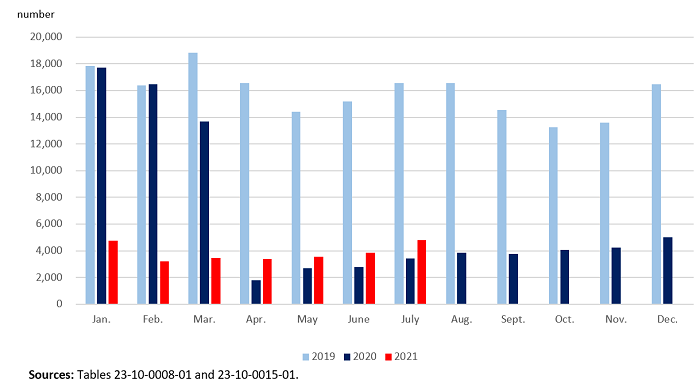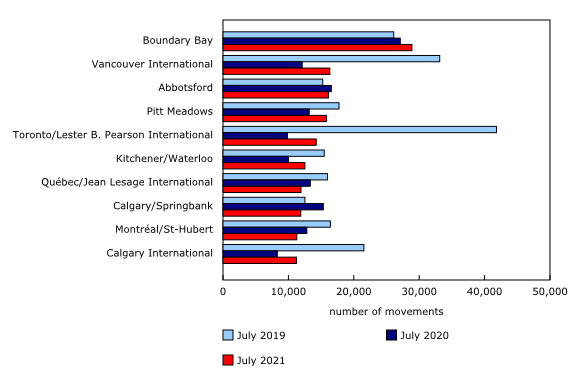Aircraft movement statistics: Major airports, July 2021
Archived Content
Information identified as archived is provided for reference, research or recordkeeping purposes. It is not subject to the Government of Canada Web Standards and has not been altered or updated since it was archived. Please "contact us" to request a format other than those available.
Released: 2021-09-27
420,972
July 2021
9.3% 
(year-over-year change)
Highlights
In July, there were 420,972 aircraft movements at Canada's major airports. This increase of more than 35,000 movements from July 2020 pushed aircraft activity to its highest level in more than a year and a half. Despite this gain, total air traffic was down almost one-third (-31.5%) from July 2019, before the pandemic.
Domestic movements by level I-III and foreign carriers reached more than 100,000 for the first time since March 2020. Movements to and from the United States surpassed 10,000, also the highest number since the onset of the pandemic in March 2020.
In July, wildfires contributed to an increase in domestic air traffic at many airports. The largest increases compared with July 2019 occurred at Kamloops and Penticton, both in British Columbia, and at Kenora, Ontario.
Canada's three most active airports in July were British Columbia's Boundary Bay (28,885 movements), Vancouver International (16,331) and Abbotsford (16,119).
July sees some easing of travel restrictions
Canada began its first phase of easing travel restrictions on July 5, 2021. As of this date, mandatory testing upon arrival in Canada with a hotel stopover as part of a 14-day quarantine—which had been in force since February 2021—was no longer required of fully vaccinated Canadians and permanent residents.
July is the busiest month in more than a year and a half
In July, there were 420,972 aircraft movements at the 90 Canadian airports equipped with NAV CANADA towers and flight service stations. This was an increase of 9.3% from July 2020 and the highest number since November 2019.
Compared with July 2020, itinerant movements (flights from one airport to another) increased by one-fifth (+20.2%), while local movements (flights in the vicinity of the airport) were down 6.6%.
Despite these overall gains, total aircraft movements in July were 31.5% below July 2019, prior to the pandemic. Itinerant movements were 35.2% less and local movements were down by 23.4%.
On March 11, 2020, COVID-19 was declared a pandemic by the World Health Organization and, in the months that followed, total aircraft movements remained well below historical levels. Unless otherwise specified, comparisons are made with the same month of 2019, when aircraft movement levels were in line with historical trends.
Domestic and international movements both up
At 258,708 movements, total domestic traffic (within Canada) in July was more than 40,000 movements higher than in July 2020, but represented 71.5% of the pre-pandemic level reported in July 2019. With vaccination rates continuing to rise and the further relaxation of provincial restrictions, domestic movements in July by level I-III and foreign carriers grew to over 100,000 for the first time since March 2020, as passenger carriers ramped up their schedules.
Even with this growth, the volume of air traffic by these same carriers was at 58.2% of the pre-pandemic level from July 2019. Nevertheless, this represents an improvement from June 2021, when it was 49.0% of the amount observed in June 2019.
Transborder movements (flights to and from the United States) surpassed 10,000 in July, reaching their highest level since March 2020. However, they remained less than one-quarter (23.9%) of the pre-pandemic level from July 2019.
Weekly aircraft movements indicate that transborder movements continued to rise through August, as restrictions for fully vaccinated US citizens and permanent residents coming to Canada were relaxed on August 9, 2021.
Other international traffic also increased year over year in July and was at its highest level since December 2020, but stood at 29.1% of the pre-pandemic movements reported in July 2019.
Aircraft provide critical support battling wildfires
In July, wildfires contributed to an increase in domestic air traffic at many airports around the country. Three of these airports had notable increases from July 2019: Kamloops (+1,846) and Penticton (+1,318), both in British Columbia, as well as Kenora (+1,305), in Ontario.
Both fixed-wing and rotary aircraft (i.e., helicopters) play a critical role battling wildfires. Helicopters are used to transport and rappel crews and equipment, to conduct infrared scanning, to map or observe fires, or to drop water or fire retardant.
In Kamloops, for example, half (50.0%) of the 4,708 domestic takeoffs and landings in July were by helicopters, close to three times the five-year monthly average (16.3%) from 2015 to 2019. Meanwhile, various commercial passenger flights were cancelled toward the end of the month due to heavy smoke.
Canada's busiest airports
Canada's three most active airports in July were British Columbia's Boundary Bay (28,885 movements), Vancouver International (16,331), and Abbotsford (16,119). Bolstered by an uptick in domestic activity, Vancouver International made its first appearance in the top three since December 2020.
Also in July, the five busiest passenger airports from 2020 handled their largest number of arrivals and departures since the onset of the pandemic in March 2020. Four of those airports—Toronto/Lester B. Pearson International, Ontario; Vancouver International, British Columbia; Calgary International, Alberta; and Montréal/Pierre Elliott Trudeau International, Quebec—continued to be the only ones accepting scheduled international commercial passenger flights. This was expanded to nine airports starting August 9, 2021.
Note to readers
The Aircraft Movement Statistics: Major Airports Survey collects data on itinerant and local aircraft movements at major airports in Canada.
Major airports include all airports with either a NAV CANADA air traffic control tower or a NAV CANADA flight service station.
On November 5, 2020, NAV CANADA recognized the increase in air traffic at Red Deer Regional Airport in Alberta before the COVID-19 pandemic and changed its status from a flight service station to offer air traffic control service at the airport for 16 hours a day. As a result, effective November 1, 2020, monthly aircraft movement data for the airport are available in tables 23-10-0002-01 to 23-10-0008-01 (airports with NAV CANADA towers). Data prior to November 2020 remain available in tables 23-10-0009-01 to 23-10-0015-01 (airports with NAV CANADA flight service stations).
An aircraft movement is defined as a take-off, landing or simulated approach by an aircraft, as defined by NAV CANADA.
Data for July 2020 may have been revised.
The data in this monthly release are not seasonally adjusted.
Contact information
For more information, or to enquire about the concepts, methods or data quality of this release, contact us (toll-free 1-800-263-1136; 514-283-8300; STATCAN.infostats-infostats.STATCAN@canada.ca) or Media Relations (613-951-4636; STATCAN.mediahotline-ligneinfomedias.STATCAN@canada.ca).
- Date modified:






